|
An
Overview of Bf 109E Camouflage and Markings, 1939 - 1940 Dave
Wadman ©1999-2002 |
Confirming
the identities of the camouflage colours and patterns worn by Bf 109Es during
the Battle of Britain presents an intriguing but complicated challenge. While it
is known for the most part that the undersurface colour was usually a readily
identifiable light blue[1],
the diversity in upper surface patterns and colours is far more difficult to
ascertain.
Splinter Scheme or Single
Colour?
|
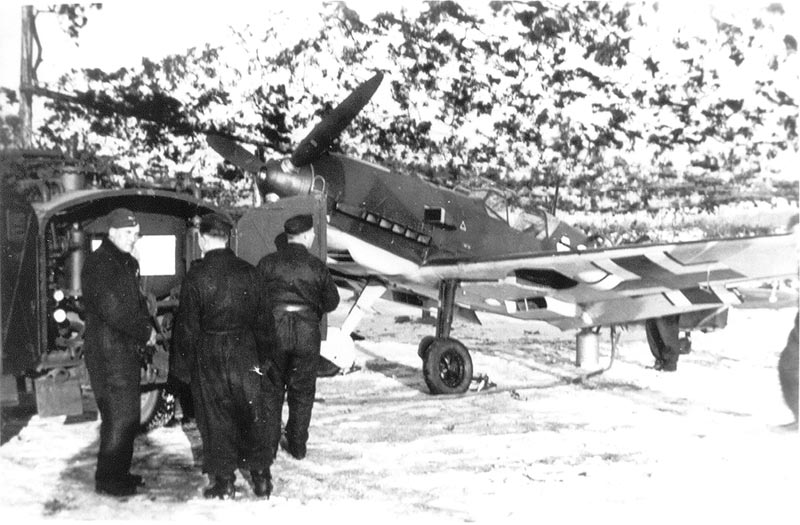
This fascinating photo
demonstrates the low tonal contrast of the 70/71 scheme; noteworthy also
is the exceedingly large underwing Balkankreuz applied after the
Polish operations, as well as the Staffel color used on the
supercharger intake lip and gun troughs. One last point of interest
concerns the very dark paint on the gear legs, contrasting with what
appears to be 65 used in the gear wells themselves; the darker area is the
zippered liner. (Crow) |
A
careful study of photographs of the camouflage worn by Bf 109s in
northwest Europe in the months prior to the beginning of World War 2
reveals that the upper surface splinter patterns of Black-Green 70[2]
and Dark Green 71[3]
were applied with sharply defined, angular demarcation lines in keeping
with standard Luftwaffe camouflage practice.
The patterns applied to the Bf 109B, C and D variants were
similarly typical for the E-1 and E-3 which, as with the earlier models,
displayed considerable variation on the fuselage sides where the pattern
in plan view was extended down to meet the undersurface colour. This
remained essentially unchanged until the final months of 1939 when a more
simplified form of 70/71 splinter pattern began to make its appearance on
some E models. |
| By
the outbreak of war in September 1939, the camouflaged upper surfaces of Bf
109’s were being regularly identified in Allied sources as being ‘dark
green’, implying the use of a single colour rather than the two dark greens
officially specified by the Reichsluftfahrtministerium (RLM) in L.Dv
521/1[4]
issued in March 1938. Did
these observations accurately record that a single upper camouflage colour was
being used or did the low tonal contrast between them prevent clear
identification of the two separate colours or, more simply, was this due to
fading through in-service use and weathering?
|
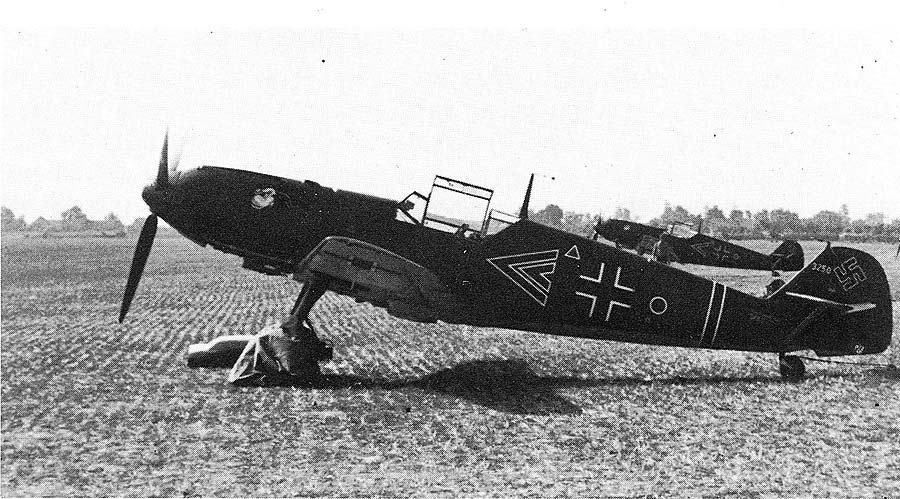
This photo of a I./JG77
Stab aircraft clearly illustrates the apparent single-tone uppersurface
camouflage referenced in the article. (via MacDonald) |
During
late 1939 - early 1940 and with the Luftwaffe fully committed to its
wartime operations, the probability of a single upper camouflage colour being
applied to individual aircraft or those of a specific unit is entirely credible.
Although no valid or 100% supportable documentary evidence of any Bf 109s
with a single upper camouflage colour during this period has yet been
discovered, it remains entirely plausible to assume that, for whatever
reason, some aircraft may have received a single colour
finish to the upper surfaces on either
a temporary or permanent basis.
In
the recent careful examination of a number of good quality original photographs,
the presence of a single upper surface colour on some aircraft is strongly
indicated and in the careful scrutiny of these original prints by several noted
researchers, to date, no discernible evidence of a second colour has been
determined with complete certainty. Nevertheless,
and until factual evidence to the contrary is discovered, it may
perhaps be presumed that contemporary references to a single dark green are
nothing more than a broad generalisation of the camouflage colour.
The singular ‘dark green’ reference possibly being due as mentioned
earlier, to the low tonal contrast between these two colours?
The Colours Change
Although
the standard camouflage on the Bf 109 at the outbreak of war, the fighting in
Poland made it clear that while the 70/71 scheme was more than adequate for
ground concealment, the same did not hold true for aerial combat.
Consequently, numerous field trials to find a suitable replacement were
undertaken during the winter of 1939-40 utilising various combinations of the
colours Grüngrau[5]
02 and the greens 70 and 71. The successful outcome of
these trials resulted in a new camouflage pattern of 02 and 71 that was
considered more practical for the then current operations than the earlier
scheme. Accordingly, an order was issued dictating that 02 would replace
Black-Green 70 in the pattern. Almost concurrently, the demarcation for the
undersurface Blue 65 was increased in height to cover approximately
three-quarters of the fuselage sides, including the entire sides of the vertical
tail surfaces. Although
this change effectively restricted the upper colours to the strict plan view of
the aircraft, the actual height of the demarcation varied considerably between
aircraft, most prominently on the rear fuselage between the rear of the cockpit
canopy and base of the fin.
Beginning
in early 1940 with production of the Bf 109E-4, the 02/71 scheme was applied as
a factory finish, whereas the earlier E models already in service appear
generally to have been repainted at either local or unit level as and when time
allowed, with the attendant broad interpretation of the contents of the order.
Some units were noticeably slower than others in implementing the change and
even for those repainting their aircraft promptly it must be realised that not
all aircraft within a single unit would or could be repainted at the same time.
On some aircraft the 02 replaced the Dark-Green 71 rather than the Black-Green
70 as directed, while on many others, only the smaller areas of tail and
fuselage sides were repainted in Blue 65 thus leaving the tops of the wings and
fuselage uppersurfaces in the earlier greens. That this occurred is evident from
photographs and the contents of intelligence summaries, which indicates that a
number of Bf 109s in a variety of these finishes survived well into the early
autumn of 1940 and beyond. Furthermore, it is entirely possible that many of
these may have been either older aircraft or those held as reserve or
‘spare’ aircraft, retaining their finishes until they were either lost on
operations or underwent major servicing, at which time the newer scheme would
presumably have been applied.
With
these changes, which included revisions to the size, style and placement of the
national insignia, several different examples of a simplified splinter scheme,
including ‘mirror’
image reversal patterns, began to appear. In these, the colour divisions were
far less angular than those of the original patterns and are often seen in
photographs to have a ‘feathered’ rather than sharp demarcation. Although
official confirmation for this simplification is unclear, it is reasonable to
assume that they were implemented as a means both to expedite service
requirements and to save on materials and cost, regardless of whether the finish
was of factory or in-service origin.
The
Summer Battles of 1940
As
the aerial battles developed above the southeastern coast of Britain and the
English Channel in the mid-summer of 1940, it soon became clear that again, more
changes would be necessary to the camouflage worn by Bf 109s. Whereas the
02/71/65 scheme had worked sufficiently well over France and the Low Countries,
it was found that this was not the case in the air war against England.
The high demarcation level of Blue 65 on fuselage sides and tails made
the aircraft stand out conspicuously against the waters of the Channel and the
colours of the English summer countryside. To overcome this, several methods
were employed to tone the blue down, the most common being an application of
mottling to fuselage sides in 02 and/or one or both - on 70/71 finishes - of the
upper surface colours. One of the earliest reports of this occurred in mid-July
when Bf 109s of JG 51 were reported as having a fine, pale grey ‘overspray’
applied to their fuselage sides; an indication perhaps of one of the first uses
of 02 in this manner. Taking into account the requirement to tone these areas
down, it is entirely feasible that an order was originated, either at RLM
level or from local area command with RLM approval, allowing individual
units, notably
JG's 2, 53 and 54, to determine the extent and style
of application as was dictated by their operational requirements.
As
the variations in mottling are far too extensive to describe in detail, it must
be realised that while little similarity existed between individual units, a
general uniformity of style and pattern was usually found amongst aircraft of
the same unit. Believed for the
most part to have originally been 02, it was usually sprayed along the sides of
the fuselage and fin in varying degrees of density and pattern. On some aircraft
it was occasionally intensified, usually where a colour transition was made such
as at the roots of the wings or tailplane, by the random inclusion of one or
both – if 70/71 - of the upper colours.
|
In
contrast to this the mottle used by some units was applied in a much
coarser form, suggesting the use of a brush or sponge, frequently applied
so densely that it took on the appearance of an almost solid colour [6].
Noticeably, many aircraft wearing the coarse, stippled style of
mottle[7]
also displayed a modified fuselage cross that saw the proportions of
the white segments reduced in area to decrease their visibility.
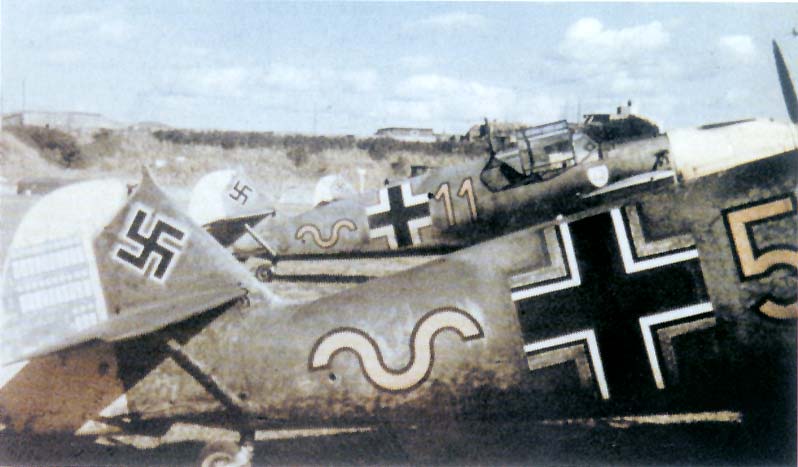
Believed to be the aircraft
of Werner Machold, this 9./JG 2 Emil illustrates the heavily applied
"stippled" camouflage pattern favored by the Richthofen
Geschwader. Also seen in
this view is an example of one of the methods used to reduce the
visibility of the white areas of the fuselage Balkenkreuz.
|
Similarly,
the height of demarcation between upper and lower colours was often
altered, with segments of the upper fuselage colours being extended down
the fuselage sides to random depths along its length.
However some units, notably the III./ JG 26, were markedly
reluctant to add any form of additional camouflage to their aircraft and
throughout most of 1940, retained the high demarcation finish with
fuselage crosses and numerals repainted in a smaller format than usual to
help conceal the aircraft at higher altitudes.
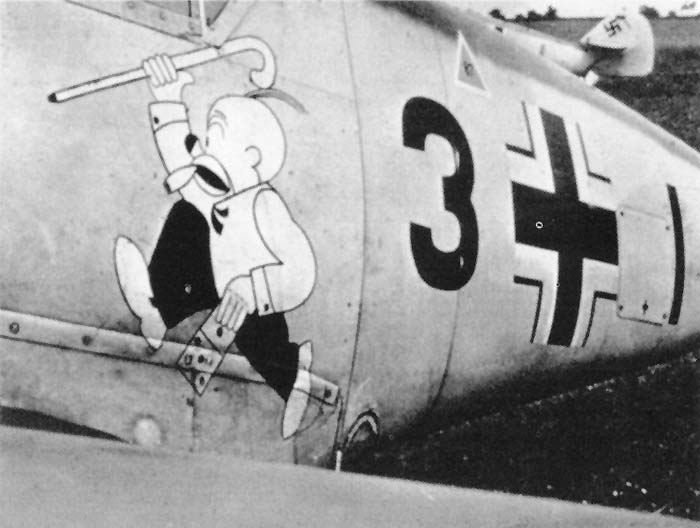
In contrast to the JG2
aircraft at left, this Emil of the 8./JG 26 showcases the smaller
numbers and high demarcation line common to the III. Gruppe of this
Geschwader. |
With
more fighter engagements taking place over the sea and increasing numbers of
replacement aircraft entering service, camouflage variations became all the more
widespread, often occurring when easily interchangeable parts such as cowlings, rudders,
armament access panels and battery hatch covers were swapped between aircraft to
expedite servicing. Additionally, two other anomalies
had appeared earlier
in the camouflage schemes.
| The
first was a lighter centre to the wing Balkenkreuz that often
extended to include areas of the arms of the cross and surrounding areas.
This may or may not have been a part of the random light
camouflage overspray occasionally applied to wing upper surfaces or was
perhaps, evidence of the overall mottled finish seen and documented as
being applied to some Bf 109Es of the
period. Although no supportable documentary
confirmation for this has been found, from photographic evidence[8]
it is reasonable to assume that, in all probability, the additional colour
was applied to reduce the visibility of the wing crosses and blend them in
to the upper surface camouflage, thus helping to conceal the aircraft from
observation from above. |

The top of the port wing of the Bf 109E of Lt.
Hans Illner of
the 4./JG 51 clearly showing the soft, irregular overspray covering the
Balkenkreuz to lessen its visibility. |
|
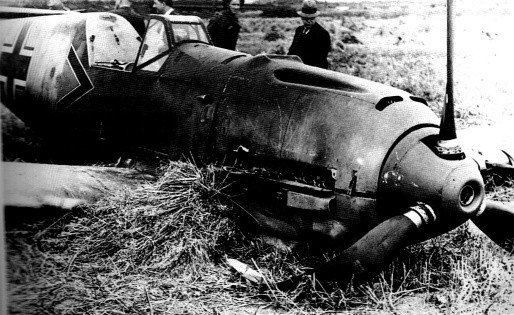
Paul Temme's Bf 109E photographed in the field adjacent to Shoreham
airfield where he was forced to land early on the morning of 13 August. The
'wrapped-around' underside 65 along the leading edge of the wing is clearly
evident. |
The
second and one that again is clearly evident in many period photographs,
was the use of a light colour that wrapped around the upper leading edges
of the main wings. This may clearly be seen in photos such as those of the
aircraft of Oblt. Paul Temme the Gruppe Adjutant of the I./JG
2 who force-landed beside Shoreham airfield during the early morning of 13
August. From the detailed
examination of photos of aircraft with this feature it is currently
understood that this was actually a continuation of the underside Blue 65
applied so as to encompass the areas of wing leading edge visible in a
head-on view. Whether this
was an attempt to break up the outline of the wings when viewed from
head-on or a characteristic of the location where the camouflage finish
was applied has not, to date, been determined with any certainty. |
Grey
Camouflage?
Although
often totally destroyed, all enemy aircraft that came down in the British Isles
during the Second World War were thoroughly examined by intelligence teams from
the Air Ministry and RAF. The
reports created from these examinations were known as Crashed Enemy Aircraft
Reports, and recorded such information as Werk Nummer, engine type,
armament, additional or special equipment and often, markings and colours.
However, and to the disappointment of many post-war researchers, there
were no set guidelines in these reports for describing the shades of the colours
found on these downed aircraft. Generally,
any examination of the paint was confined to an evaluation of the type of finish
and occasionally, some undamaged panels would be tested for paint durability.
By
mid-August, the first uses of greys and blue-greys as an upper camouflage colour
were making their appearance in these reports, appearing with increasing
frequency as the battle progressed. ‘light navy grey’, ‘two shades of
grey’, ‘light grey with dark grey mottling’,
‘Battleship grey’, ‘mottled greys’ and ‘camouflage grey’ were some
of the descriptions given, along with mention of varying shades of green-grey
and blue-grey. Were these an indication of the earliest use of the greys 74[9]
and 75[10]
that would become the standard fighter camouflage the following year or,
as recent research and correspondence indicates, that they were colours
originally created at unit level?
Since
the appearance of the original version of this article I have received written
confirmation from two former Jagdwaffe ground personnel confirming that
on occasion, various grey shades were mixed and applied to some aircraft in an
attempt to find suitable concealment when flying above the waters of the English
Channel. Confirmation that this occurred ties in with known practices
carried out on Luftwaffe aircraft where a new paint or colour was applied
to selected parts of an airframe to test its viability under operational
conditions.
It
can be found that the mixing of various combinations and percentages of the
colours 02, 65, 66, 70 and 71, or similar colours in contemporary paints will
produce a variety of grey and blue-grey shades.
Most, if not all of these ‘grey schemes’ would have been suitable for
use in the prevailing situation on the Channel Front in the latter half of 1940.
It is reasonable to assume therefore that some of these shades were no
doubt almost identical to the later 74/75 greys thus leading to the belief in
some quarters that this series of colours had been applied to Bf 109s in the
summer of 1940. However, as the use
of 74/75/76 was not officially promulgated until the November 1941 issue of L.Dv
521/1[11],
it is a wholly convincing possibility that the various greys used during 1940
were those from which they were developed.
Geschwader,
Gruppe and Staffel Markings and Colours
Stab
Markings
The
origins of markings for Stab personnel date back to the pre-war period,
being allocated to three officers of the Geschwaderstab: the Kommodore,
his Adjutant and the officer in charge of flying operations. Correspondingly
for the Gruppenstab, similar symbols were allocated to the Gruppenkommandeur,
Adjutant and Operations officer.
| The
entry into service of the Bf 109 made it apparent that the earlier Stab
symbols would need revising. For
that reason, Fl.Inst. 3 Nr.730/37 II 9 issued on 14 December 1937
by the Generalstab der Luftwaffe included a set of instructions and
diagrams for the application of markings to fighter aircraft.
Apart from containing detailed instructions on the dimensions of
numerals and their spacing, new locations and dimensions for Stab symbols
were designated, including a vertical bar symbol to be applied aft of the
fuselage cross to signify the III.
Gruppe instead of the earlier wavy line symbol.
A horizontal bar aft of the fuselage cross identified the
aircraft of the II. Gruppe while those from the I. Gruppe carried
no symbol. All symbols were to be applied in black with white edging and
a thin black outline although it is evident in photographs and other
records that these markings were not always applied in either the colours
or locations officially specified. Despite the clearly worded instructions regarding the III Gruppe
marking, at least two Jagdgeschwader; JG 2 & JG 52, declined to
effect the change, retaining instead the earlier wavy line Gruppe
symbol. In similar fashion,
the III./JG 2 and JG 54 also declined to follow the wording of the
directive by using white as the predominant colour for their Stab
symbols, usually outlining them with a thin black border.
Likewise,
the II./JG 51 also declined to display their Gruppe bar by using
the designated area to display instead their 'weeping bird' emblem. |
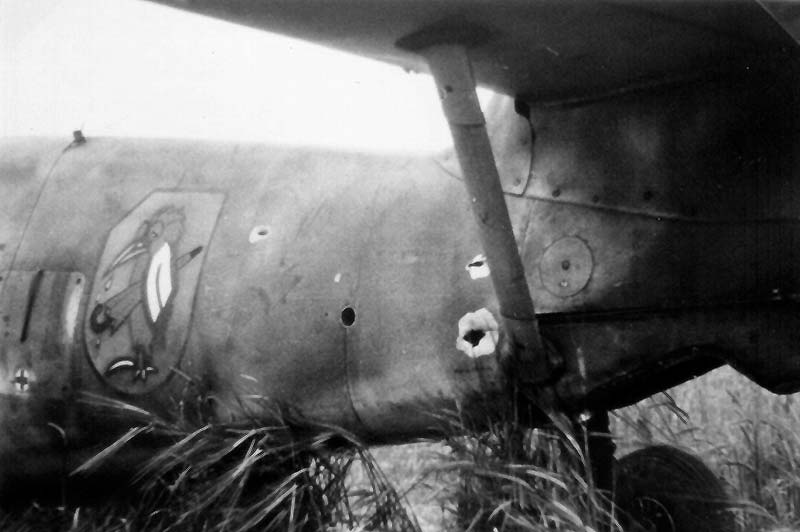
This view of the rear port fuselage side of
Illner's Bf 109E
shows the position aft of the fuselage Balkenkreuz where the II./JG 51 applied
their 'weeping bird' emblem. |
Staffel
Markings
The
ordinary Staffel aircraft carried a number identifying the individual
aircraft within the Staffel, and the colour in which it was
painted identifying the Staffel within the Geschwader. These
numbers were usually applied in one of two forms with the figures from 2 to 9
appearing in either a ‘rounded’ or ‘squared’ style that usually remained
constant within the various Staffeln.
Although
regularly positioned ahead of the fuselage cross, some units did adopt
alternative locations for these numbers. The
III./JG 27 chose to apply them to either side of the cowling beneath the gun
troughs while the III./JG 54 placed theirs on either side of the forward
fuselage, just aft of the rear edge of the engine cowling.
Likewise, there were also exceptions to the rule for Staffel colours;
on several occasions, red was recorded as
replacing the normal black of the second, fifth and eighth Staffeln,
the third (Jagd) Staffel of LG 2, used brown instead of yellow and
the 5.Staffel of JG 53 is recorded as using grey numerals throughout
1940.
|
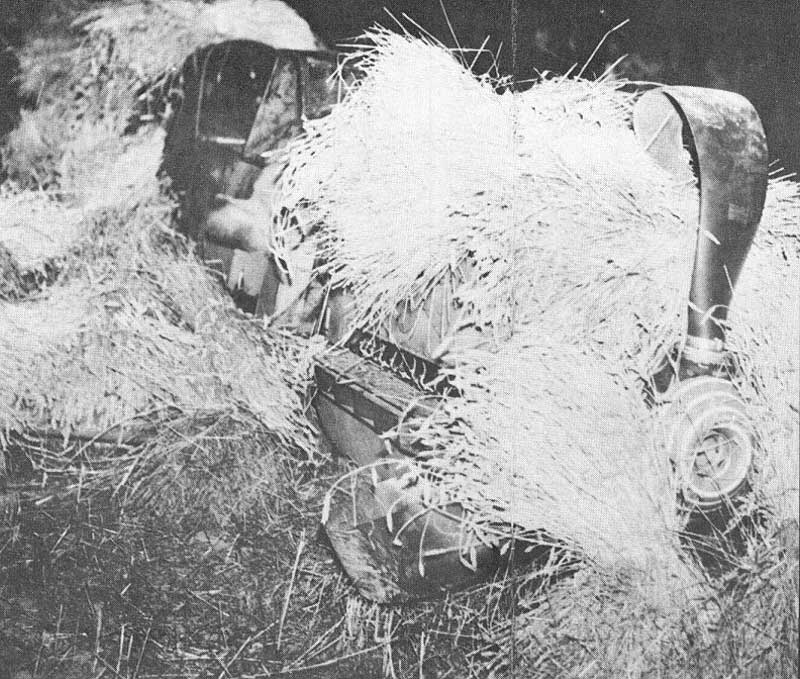
|
Spinners
too received their share of colours. These were often repainted in black
and white in the form of halves or quarters or would merely have a segment
of white applied to the base Black-Green 70 spinner colour. In many
instances the spinner tip or cap, if fitted, would often be painted in the
Stab or Staffel colour. While there are no confirmed reports
of the 1944 ‘spiralschnauze’ style of design being used at this
time, those coloured bands that were painted on Bf 109E spinners during
1940 are recorded as being applied in concentric circles.
However, it is again evident that there were exceptions to the rule
here too. For example, the Bf
109E-4 of Oblt. Helmut Tiedmann, Staffelkapitan of the 2./JG
3, was described in Crashed Enemy Aircraft Report No.7 of 21 August 1940
as having concentric rings painted on the nose of the spinner yet
published photos of the nose of this aircraft clearly show it to be a thin
spiral. |
Colours.
I,
II & III Gruppenstab
-
Green
1,
4 & 7 Staffeln
-
White
2,
5 & 8 Staffeln
-
Black
(Red)
3,
6 & 9 Staffeln
-
Yellow (Brown)
The
Red Band of JG 53
For
a short period during the second half of 1940, all three Gruppen of JG
53, and only JG 53, displayed two distinct anomalies in their markings, the
purposes of which have yet to be fully determined with 100% certainty.
The
first case concerns the replacement of the ‘Pik As’[12]
emblem. According to RAF
intelligence sources in Air Ministry Weekly Intelligence Summary No.60, the
emblem was ordered removed by Hermann Göring and a red band applied in its
place, stating that the unit was to become known as the ‘Red Ring Geschwader’.
While there is some evidence to suggest that it may have stemmed from
some personal antipathy on the part of Göring, or possibly from some
ideological difference with the leadership of the Geschwader[13],
the
definitive reason for the order has yet to be
determined. In the past, several
valid theories for this change have been examined in depth, but most have been
subsequently disproven although one, containing some merit, submits that it may
have been nothing more than a temporary identification feature. There was
however one event which transpired at this time that may have been of some
significance. During early August,
at around the time of the appearance of these red bands, Göring replaced the
majority of the Jagdwaffe Kommodore with younger men, although two units
serving with Luftflotte 3, JG 27 and JG 53, retained their existing Kommodore
until October.
Then, after Oblt. Günther von Maltzahn had taken over command of
JG 53 from Oblt. Hans-Jürgen von Cramon-Taubadel at the beginning
of October, the ‘Pik As’ emblem began to reappear on the Geschwader
aircraft in a somewhat newer and larger format than previously seen.
As a matter of interest, the first recorded incident of a Bf 109E being
brought down over England where the red band had replaced the ‘Pik As’
emblem occurred on 16 August. On
that date the aircraft of Fw. Christian Hansen of the 2./JG 53 force landed at
Godshill on the Isle of Wight and when examined was reported in Crashed Enemy
Aircraft Report No.11 of 19 August 1940 as having a “red band around nose 6”
wide”.
| The
second case, and one frequently recorded as a political gesture on the
part of the Geschwader, occurred almost concurrently with the
reintroduction of the ‘Pik As’ emblem. Many aircraft from the
II and III Gruppen had the Hakenkreuz on their fins
overpainted with several pilots using these areas to display their
individual Abschuss tallies rather than in the more usual location
on the rudder. Although some
aircraft of the Gruppen did re-apply the Hakenkreuz after a
short period of time it was often placed on the rudder rather than
in the usual position on the fin. The
period of time that these anomalies with the Hakenkreuz covered is
not known for certain but some aircraft of the III./JG 53 were
photographically recorded as still without their Hakenkreuz in late
November 1940[14]. |
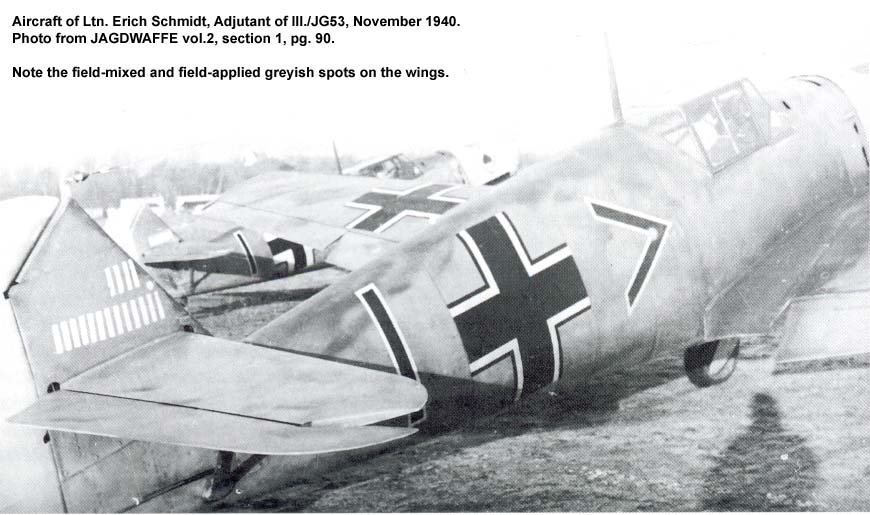
Photo
of the III./JG53 Gruppenadjutant Ltn. Erich Schmidt's Emil illustrating
the absence of the Hakenkreuz on the fin; photo dated Nov.
1940. Behind Schmidt's aircraft can be seen another Emil carrying
the "Pik As" badge. |
Tactical Markings
The
requirement that visually, a military aircraft should be invisible to its foe
but instantly recognisable to friendly forces is something of a practical
impossibility, and throughout the history of military aviation, numerous methods
to resolve this problem have
been examined. With the Luftwaffe it was no different. In mid-August, the
first incidents involving Bf 109s carrying distinctive yellow markings were
being reported by RAF pilots who initially interpreted these markings, albeit
incorrectly, as symbolising the aircraft of a ‘squadron of aces’.
The
earliest examples of the use of these markings occurred when aircraft of JG 26
and JG 54 were recorded as carrying areas of yellow paint applied to wing and
tailplane tips and also to top sections of rudders and on occasion, to the
vertical trailing edge section
of the rudder. There is little doubt that these markings were established as an
aid to instant recognition in the air where such conspicuous markings were
invaluable to both sides. In appreciation of this value, the Jagdwaffe
were quick to increase the use of such colours to include cowlings and entire
rudders. Whereas the application of either yellow or white
paint
to wing and tailplane tips remained relatively constant from unit to unit, this
was not often the case where cowlings and rudders were concerned.
On
rudders, it first appeared in the form of an inverted triangular area on the top
section as may be seen in photo's of the Bf 109 of Gerhard Schöpfel of the
III./JG 26 circa mid - August. Not
long after this, other Bf109Es, often noted as being from the III./JG 54, were
recorded as having approximately one-third of the rear vertical rudder surface
painted yellow or possibly white, while on Bf 109s of other units, the entire
rudder was finished in one of these colours. When the whole rudder was painted,
the exact area covered frequently varied as a
section of the original Blue 65 would
often be left on which the pilot would display his 'Abschuss' tally,
usually marked as black or red vertical bars that often identified the
nationality of the victim and the date of the victory.
In addition to the painted rudder variations, at least two Bf109Es of the
period are documented where the fin was also painted in yellow or white but
based on currently available information, these are seen to be the exception
rather than the rule at this time.
|
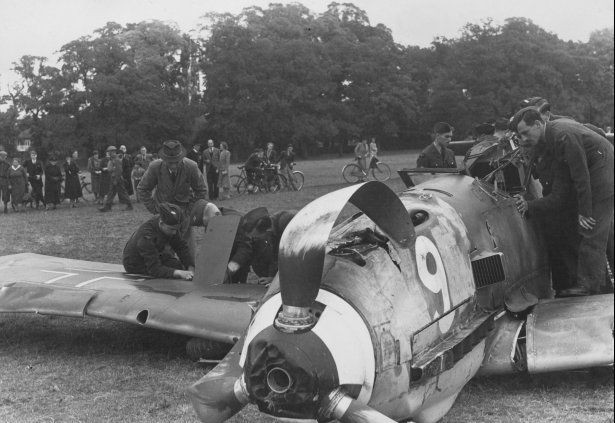
This view of the 7./JG 27s Oblt. K. Fischer's Bf 109E-1 lying in Windsor
Great Park on the afternoon of 30 September illustrates the aircraft number
applied to the side of the engine cowling, a feature of aircraft of the
III./JG 27. |
With
cowlings, it can be seen from
photographs that the area covered by white or yellow paint varied
considerably between aircraft, often extending
rearwards as far as the base of the windshield. Any unit emblems that
would otherwise be hidden by this paint were usually masked off carefully,
and two such units, the I./JG 3 and the III./JG 27, masked off the
distinctive JG 3 ‘Tatzelwurm’ and JG 27 numbers so as to leave
them on a conspicuous rectangular background of the camouflage colour.
From late August on, it is unusual to find a photograph of a Bf
109E without some part of its airframe covered in either yellow or
white paint, and
to date, no significant explanation for the use of the two different
colours has been ascertained, suggesting that they may have been used
somewhat indiscriminately. In addition to the use of yellow and white for
these tactical markings, it is also claimed in some sources that red was
used for the same purpose. However, despite several detailed
investigations to date, no photographic or documentary evidence whatsoever
has been discovered to support this claim. |
Although
some references suggest that
the
change from yellow to white occurred
at the end of August, it is evident from the contents of Crashed Enemy Aircraft
Reports for the month of September that both colours were being used
concurrently by different units during that time. As far as research to date has
shown, it would appear that this use of white lasted only for a period of
approximately three or four
weeks
and was seemingly confined in the main to units based within a small sector of
occupied France. During the last week of August, the fighter units of Luftflotte
3 were placed under the control of Luftflotte 2 when the bomber units of
the former were temporarily withdrawn from daylight operations in order to join
the nightly attacks on centres of industry in the British Midlands. However,
whether or not this was in any way connected with the use of the white tactical
markings for the single-engined fighter force, remains a matter of speculation
for the present.
Canopy
Framework
One
other area of airframe colour that deserves mention is that applied to the
canopy framework. For the earlier canopy style as fitted to the E-1 and E-3,
photographs show that while the external areas were usually finished in
accordance with those colours used for the upper camouflage, the internal faces
could be finished in either 02 or a darker grey that, in all probability was
Black-Grey 66. However, with the
introduction of the heavier framed canopy and windscreen that was introduced on
the E-4,
recent
investigation by Dutch and German researchers has established that both inner
and exterior faces of the framework was painted in Black-Grey 66 at the source
of manufacture, often leaving any external camouflage colour(s) to be applied at
a later date or at unit level. Therefore
it is reasonable to assume that in period photos of 109 variants with heavier
framed canopies[2]
that appear to be in a single, very dark colour were, for whatever reason and in
all probability, left in 66 rather than having the appropriate camouflage colour
applied.
|
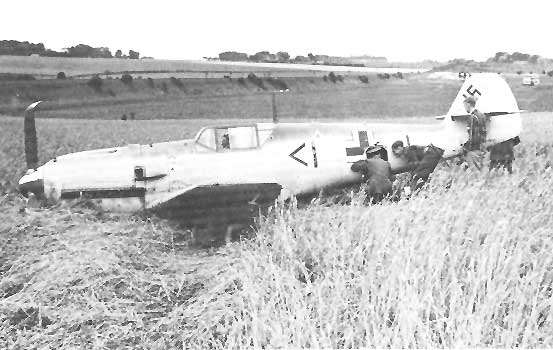
In
this view of Bf 109E-1 W.Nr. 6296F (F= flugklar,
or repaired to airworthy status) belonging to Werner Bartels of the
III./JG 26, the retrofitted later canopy style may
be seen to be in a different shade than the surrounding fuselage
paintwork. |
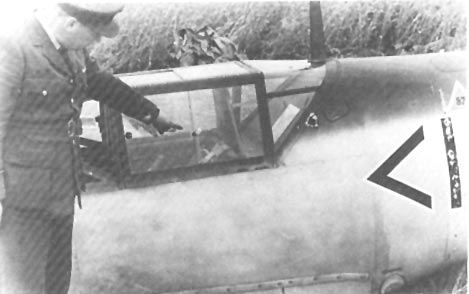
Upon
closer inspection, some overspray from the repainted aft fuselage may be
found on the rearmost portion of the canopy, while the windscreen and hood
itself retain the coat of overall 66. Interestingly, this
view of the cockpit area of Bartels' E-1 indicates what may well have been
an all Black-Grey 66 interior. |
In
Conclusion
While
it is a well-recognised fact that the RLM had a clearly defined
administrative intent to regulate Luftwaffe camouflage practices, it must
also be distinctly understood that, as surviving documentary and photographic
evidence reveals, there were many exceptions to its established edicts.
Unfortunately, since very few original documents or diagrams are available from
which definitive information can be obtained; much of the interpretation for
these variations must rely heavily on informed and educated speculation based
upon such material and knowledge as is currently available.











